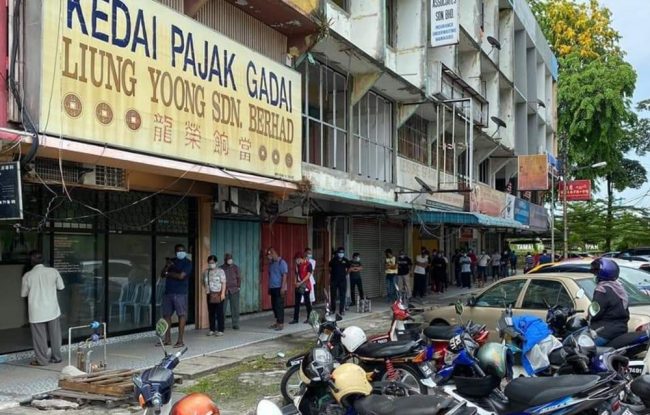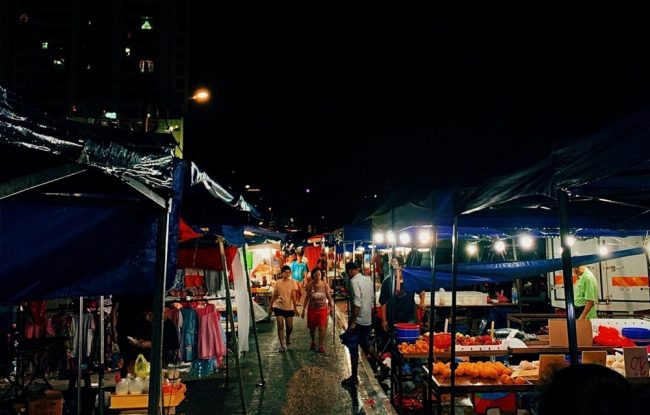I was invited for a visit to the official venue of the George Town Literary Festival 2017 by Gareth Richards, an editor, bookseller and the co-curator for the festival. The festival’s director, Bernice Chauly and the co-curator, Pauline Fan were also present.I arrived a bit later and was greeted by Gareth himself. There was a newspaper-sized paper folded under his armpit. I could not exactly guess what it really was. All I could see was part of an illustration that looked like Angkor Wat with a half revealed title, and that was enough to arouse my interest.
We toured the rooms in the old colonial building that is located at Gat Lebuh China for a few minutes just to get a clearer picture of the festival that took place later in November. We finished the tour and went outside for a puff. That was the moment when Gareth unfolded the paper he was holding and proudly showed to us, “Mekong Review”, as written on the front page.
“A quarterly literary magazine from the mighty river of Mekong” he introduced. “It is available in my bookshop for RM20”. I looked passionately at the magazine while he was describing and slowly flipping each page, scanning all the essays, book reviews, poetry and interviews. “This is a magazine that covers political and cultural issues in the Southeast Asia region, particularly Cambodia, Myanmar, Vietnam, Laos and Thailand, look at it!”.
My curiosity towards the magazine grew bigger not because of its contents that I had not had a chance to look at, but because of the physical presentation of it; the size, artworks, type of font, etc, all of the aspects that had contributed to the elegance of the print. I went home to dig for more information from its website. The next day I dropped by at Gerakbudaya bookshop and happily got myself a copy of each available issue.
“Penang literary scene would be more exciting with the existence of this magazine”, I thought as I walked out from the bookshop. “At least we have more stuff to read and more importantly, we can get to know our neighbours rather closely. The neighbours that we hardly ever talk to”.
***
A few months passed, I met a guy in his early fifties during a photo exhibition in Penang. He was sitting alone at a corner, unenthusiastically finishing his black coffee, though soon I found out that he had not yet found his real drink. He was dressed in a blue t-shirt with a red-patterned Cambodian scarf wrapped around his neck during the scorching hot afternoon, the kind of style that would be donned by mad writers. As I approached and greeted him, he stood up and introduced himself in Australian accent as Minh Bui Jones.
A former journalist, co-founder of The Diplomat and a beer aficionado, Bui Jones now edits the rising Phnom Penh-based magazine. He lives in Sydney, Australia but frequently finds himself sitting in Penang’s Antarabangsa-liked ‘bars’ and cafés everywhere in Southeast Asia and Europe. He drags his luggage full of Mekong Review, crossing streets and alleys, finding bookstores to place the magazine. Now the magazine has reached its international audience in prominent cities like Penang, Kuala Lumpur, Hanoi, Saigon, Singapore, Sydney, London, Stockholm and Los Angeles.
I pulled a stool and sat beside him. A small crowd of attendees were coming in and out, chitchatting while observing the photos that narrated the Malaysian underground punk music scene displayed on the wall. A ska-punk song was playing softly from another corner, cheering up the attendees. The rest of my visit at the exhibition was spent with him, talking about the magazine that I had just fell in love with, writing and our favourite drinks.
“Readers are becoming more technology savvy. E-books and digital publications are getting popular. Why did you choose to print while it is economically impractical?”, I asked Bui Jones after a few words of self-introduction.
“I love print.”, he answered.
“As a reader I love its physicality, the fact that I can hold it, take it with me wherever I go and pass it on to a friend. I love it also because it’s uncomplicated, like it doesn’t require electricity and I don’t need to turn it on – it’s just there.”
I took another sip of my coffee which started to taste bland. I nodded and let him share his thoughts. Conversations around us turned into white noise as I found myself listening to him. “For myself, I absorb better what I read when it’s on paper. It’s partly habit and partly the medium – there are no ads and distractions. When I read things off the screen I tend to skim read and I tend to rush through it, so sometimes there is pleasure in it at all”.
Bui Jones paused for a moment. His eyes were fixed on one of the pictures, I assumed his mind was elsewhere.
“As an editor, I love print because it’s a medium that I understand and can relate to. Creating a print magazine comes naturally to me. It’s like cooking your favourite dish; you don’t have to think about it”, he said passionately.
“What I also love about the magazine is the history behind it. How many magazines were cultural products of their times, organs for political and social causes, often progressive ones. A magazine ought to embody a cause, a belief or at least a sentiment. As a journalist, I see a magazine as supplementary to a newspaper. The latter tells us what happened, the former why it happened.”
“But every time I cook without thinking, my dish would turn into a disaster!”, I interrupted jokingly.
Today, when mostly everything, from newspapers to books are digitalized, Mekong Review boosts our excitement of reading printed words on papers. This is even more obvious when Leonid Bershidsky in his article titled “How print beat digital in the book world” published in The Sydney Morning Herald summarizes that in 2016, the unit sales of printed books in the US increased by 3.3 percent while e-books appeared destined for an even bigger decline than the 14 percent drop registered in 2015.
The rise of print book sales and decline in e-books in the past few years is a good news for kindle-naïve readers like me. In Malaysia, despite the irony of censorship law that has been practiced since before the independence and the government attempt to adapt to a modern knowledge-based economy, the number of publication of materials in print form shows an increasing trend every year and accounting for more than 99 percent of total annual sales worldwide, as reported by Malaysian Book Publishers Association.
Started as a magazine with a relatively small editorial team, with the help of family and friends, and money was always brought up as the main constraint to run the magazine like other mega loaded fashion magazines, Bui Jones had to find his own ways. While subscription for digital version helps to pay the contributors, he still relies on friends to “smuggle” the printed magazine, crossing borders by land and sky to its destination, pro bono. Sometimes he delivers himself and words of mouth is the main method of advertisement.
“But you are now living in Australia. Why choose Southeast Asia as the focus of the magazine?” I wondered curiously.
“It is simply because of who I am and where I was living at the time when the magazine was created. I’m Vietnamese by birth and Australian by nationality. And although I have spent four-fifths of my life in Australia, the Vietnamese heritage has always been there and seems to grow stronger by the day”, Bui Jones dug deeper into his past.
“And I have lived and worked in Thailand and Cambodia, and travelled to Vietnam, Singapore, Malaysia frequently. Each of these countries mean something to me. For instance, Malaysia was the country that my family and I landed in when we left Vietnam as refugees, as boat people. The Mekong Review was conceived and created when I was living in Cambodia, in 2015.”
“Is it a medium to connect countries, particularly writers in the region?” I asked. I wonder whether he has a bigger reason than just holding a physical copy, or if he aims to connect Southeast Asian countries and hunt local writers out of their hidings, the young and the established.
“That I can’t say, because I don’t know. I think Mekong Review, like other publications and cultural endeavours, by simply existing we are doing something, though what that something is it’s hard to know. I get asked this question quite often and I really don’t have an answer for it. Maybe if we’re still around after 10 years I might have a better idea.”
For Bui Jones, creating the magazine that is getting well-known is not a walk in the park. He looks for potential contributors himself and let their creativity churn as the writers themselves decide what to write instead of assigning them with topics. This requires him to read and research on topics that he is unfamiliar with. The process excites him more than the final result.
“All I can hope is that people find us useful and interesting.” he added.
“Yes, you are!”, I praised.
***
After 3 years of its founder travelling around the region, shaking hands with people who have turned into the very building blocks of the magazine, now Mekong Review is found in every corner of Southeast Asia. Its horizon has expanded beyond mainland Southeast Asia to include Malaysia, Singapore and Indonesia, and its readers are scattered, waiting eagerly for the next issue, all across the globe.
And after a month of idle, I bumped into him again, crossing Kapitan Keling street walking towards Gerakbudaya bookshop. This time, he dragged a bigger luggage of Mekong Review, readied to be restocked at the shop.
Mohd Izzuddin Ramliis a writer and a translator. He works as an analyst at Regional and Urban Studies, Penang Institute.
This is the opinion of the author and does not necessarily represent the views of IMAN Research.




